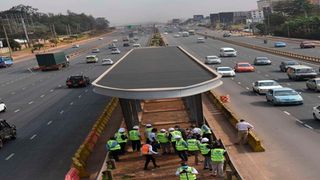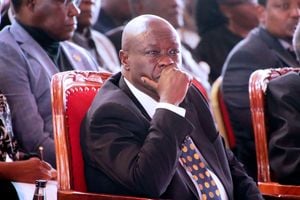
The ongoing construction of the Bus Rapid Transit (BRT) infrastructure along the Thika Superhighway on June 15, 2021. Evans Habil | Nation Media Group
| Evans Habil | Nation Media GroupNews
Premium
Dar leads the way in modernised transport as Nairobi falters
What you need to know:
- In Nairobi, public transport is at a crossroads and despite all official promises there is no clear plan on how to proceed.
- Dar es Salaam Rapid Transit system boasts bus lanes separated from other traffic, mostly in the middle of the road to reduce stoppages.
Dar es Salaam is leading in modernising its transport system even as efforts by the Kenyan government to end commuters' transport nightmares in Nairobi appear to be on the rocks.
The Dar es Salaam Rapid Transit (Dart) now has 210 BRT buses. Conversely, Nairobi’s dreams to have dedicated lanes for the much-publicised BRT remains a boardroom plan, leaving residents to their own devices.
In Kenya, public transport, especially in Nairobi, is at a crossroads and despite all official promises there is no clear plan on how to proceed, with city fathers and the national government yet to agree on the BRT model to be adopted.
For almost a decade now, the Nairobi Metropolitan Area Transport Authority (Namata) has been promising to embrace BRT as a means of providing a high-quality rapid transit system quickly at a relatively low cost.
With just weeks away from the date the first BRT was to be implemented on Thika Road – on February 1, 2022 - the infrastructure skeletons remain the same along the busy road.
In June, Nairobi residents were promised by Namata that the buses would start rolling out in February 2022, which remains a dream.
BRT, which was to start operations by the second half of 2021, was pushed to February 2022, Namata Director-General Francis Gitau said.
At the time, he blamed the Covid-19 pandemic for the delay but insisted that residents will start enjoying BRT buses by early the next year.

The ongoing construction of the Bus Rapid Transport (BRT) station by the Kenya National Highways Authority (KeNHA) along Thika Road Superhighway.
“The Thika Road BRT, which is government-funded, saw the communication plan delayed due to Covid-19 as we could not congregate like before. This led to shifting everything close to a year. But now we are moving forward to see it completed by February 2022,” he said back then.
Speaking to Nation.Africa, Mr Gitau said they planned to have the BRT Nairobi depot located in Kasarani to be ready by February.
“We have been forced to delay and slow down with the contractor because of some cash-flow issues but we are working to get back to work soon,” he said this week.
He promised to provide more information but had not done so by publishing time.
Just like Dar es Salaam’s, the Nairobi BRT will be operated by the private sector, not the government. It is, however, still not clear who will own the buses.
The government plans to launch six BRT corridors in Nairobi.
Priority corridors are Jomo Kenyatta International Airport to Likoni Road; James Gichuru-Rironi; and Bomas to Ruiru. Other motorways are Ngong Road, Juja, Mama Lucy, T-Mall and Balozi-Imara.
The corridors are expected to hold up to 950 high-capacity buses, reducing travel time and cost by up to 70 per cent.
Kenya is seeking to offer a private firm a 12-year concession to run the BRT system on Thika and Mombasa roads to ease traffic in Nairobi.

Nairobi Metropolitan Area Transport Authority (Namata) Director General Francis Gitau (right) and Engineer Michael Njogu during the inspection of the ongoing construction of the Bus Rapid Transit(BRT) along Thika Superhighway on June 15, 2021.
But as Kenya’s plans remain at the planning stage, in 2021, the multibillion-shilling Tanzanian project received a major boost after the government released 70 buses held at the Dar es Salaam port.
The €134 million-worth vehicles were released by Dar es Salaam regional commissioner Amos Makalla, who received and allowed the vehicles to start operations to ease commuter transportation nightmares.
The buses have increased the fleet operating on the 21.1km BRT network.
Dart spokesman William Gatambi told The Citizen that the number of buses plying the BRT routes had increased to 210 following the decision.
“This has enabled BRT to introduce four new feeder routes compared to the past when we had two. The new feeder routes are the Kibaha-Kimara, Mlonganzila-Kimara and Magufuli-Kimara, Mwenge via Morocco,” he said.
In Kenya, Transport Cabinet Secretary James Macharia told Parliament in 2019 that the government would spend Sh5.8 billion to build a lane for high-capacity buses on Thika Road in a bid to ease Nairobi’s traffic congestion.
“The design infrastructure is going on under Kenha (The Kenya National Highways Authority), which has estimated the cost to be Sh5.8 billion,” Mr Macharia told the National Assembly’s Transport Committee.
Kenha is overseeing the project, one of the five BRT system corridors planned in Nairobi.
A park-and-ride facility is being set up at Kasarani, where motorists heading to the city centre can leave their vehicles and use BRT buses for the remainder of the journey.

This file photo taken on August 18, 2016 shows a Dar Rapid Transit (Dart) bus on a street in Dar es Salaam.
In 2020, Stecol Corporation, previously known as SinoHydro Tianjin Engineering Company Ltd, signed a memorandum of understanding to build the long-awaited BRT system, which is expected to support the city’s rickety public commuter services and help ease traffic congestion.
The project starts from the KNH terminal to the Ruiru Station Depot, about 27km long. The dedicated BRT line is about 20.18km.
Mr Gitau, in a past interview, said that along the line, there will be 13 intermediate stations with 24 platforms (two-line transfer stations reserved for future lines that are not counted in this project) and KNH terminal, Ruiru Depot and Kasarani Depot.
“Ten existing footbridges are currently being modified by adding staircases in the middle to allow for passengers entering and exiting the stations,” he added.
Nation.Africa has observed that work on the designated BRT stations seems to have stalled at Garden City, Safari Park, Roysambu, Clayworks, Kahawa Barracks and Kenyatta University, with no activity going on there for more than a month now.
The red barriers that had dotted the highway were removed after they became a hazard to motorists, with only the concrete ones remaining, though they have been moved to the pavements.
In Tanzania, the Dart system boasts bus lanes separated from other traffic, mostly in the middle of the road to reduce stoppages.
Ticket payment and control take place at stations rather than onboard, while step-free stations and boarding mean the entire route is accessible to people in wheelchairs or with buggies.
Morogoro Road was Phase I of the BRT project. Phase II is along Nyerere Road to the southwest, while Phase III, which is under construction, will install bus lanes on Kilwa Road to the south. Phase IV, towards Bagamoyo in the north, is in the preliminary design stage.
Additional reporting by The Citizen




